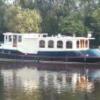

BEngo
Administrator-
Posts
6,116 -
Joined
-
Last visited
-
Days Won
2
BEngo last won the day on December 19 2017
BEngo had the most liked content!
About BEngo

Profile Information
-
Gender
Male
-
Location
Charlton Adam
-
Occupation
Retired Consulting Engineer
-
Boat Name
Jarrah
-
Boat Location
Circus Field
Recent Profile Visitors
22,032 profile views
BEngo's Achievements
Veteran II (12/12)
1.3k
Reputation
-
In 12V DC work cable size is determined by voltage drop on load, rarely by cable rating. Add up the current for all the things you want to power off the board in question. You can ignore the horn and any equally short term loads. Choose cable that produces an acceptable voltage drop with that total current. That cable will be almost certainly be rated to carry more current than anything you will put down it. N
-
Pillow (Plummer) blocks occasionally have plain bronze bearings. These will not accept thrust. Most have a deep groove ball bearing which will accept some thrust. Really sexy ones have taper roller or thrust roller bearings and can accept a LOT of thrust. It is quite possible that the OP bladeful has caused thrust and movement that has exceeded the ability of the pillow block to accept the thrust and transfer it to the boat. Not many boat gearboxes have much fore and aft play, something that caused my surveyor some surprise when he discovered about3mm pf fore and aft play in the Kelvin box. He eas satisfied when I explained how the box worked and the need for play. We would need to know more about the OPs gearbox and the thrust arrangements to be definitive.
-
Vehicle Wiring Products will crimp them up to order. Online orders. 12volt planet may also do them to order. 10 sq mm seems a bit small for battery cables. BSS likes them to be at least 25 sq mm but will accept smaller if loads are low. N
-
What dmr describes is a cup point, either large or small. Flat point has an absolutely flat end. There are several other varieties of which a cone point would fit a drilled dimple in the shaft. N
-
As MtB said. The extra weight at the bow causes the boat to pivot about its centre of buoyancy and the stern to rise. My boat also cannot be quickly stopped with an empty diesel tank (in the base of the trad engine ole) and a full water tank at the bow. Trying produces noise and bubbles, but not much else!
-

New Aqueducts - especially as part of restoration
BEngo replied to magpie patrick's topic in History & Heritage
At Grafton St the contractors proposed a more than two year closure so they coud dig a hole and put the aquaduck across it. This was not a popular proposal😁 After a good deal of argument they built a temporary, narrow ( no widebeams infesting MK in those days) bypass channel controlled by lights and built the aqueduct next to it, then removed the tempory canal and built the road down the resulting valley. There were long winter closures for the couple of years it took to build. I think these may have also resulted in a new winding hole just before the aqueduct on the New Bradwell side. N -
Check the oil level in the governor. If it is low, or empty, there is no speed signal and the spring will hold the rack in the fully open position. If nothing comes out of the petcock on the governor aft face, add diesel through the hole/flap ( as fitted to your governor) on top until diesel comes from the petcock. Check that the rack is free to move in the fuel pump- unhook the spring and it should move freely. N
-
Do you know which vehicles the engine was fitted to? If so a good starting point would be to see which carburettors were fitted to those. I doubt Watermota would change the carb on a packaged Ford engine or go through the process of deveoping a specific carb model for their engines so an automotive base seems likely. Once you have identified the base carb, probably by Solex or Zenith, then you need to look at the various jets, to get the right sizes. Alternatively swap them over from your current one. N
-
In my experience ( Epoxy coating HM's war canoes above and below waterline and owning a narrow boat since 1980 and since 2010, a grit blasted and epoxied narrowboat, with regular overcoats of epoxy) epoxy will stick beautifully to abraded epoxy. Weed scrape, then a decent pressure wash ( 3000psi at least) followed by wire brushing to shift the grey layer give an adequate key over existing epoxy. Mechanical damage is best if treated with an abrasive disc for big areas to leave a profiled surface . Pits should be washed out by a pressure washer, leaving bright spots. Surface and damp tolerant epoxy can be worked into the pits with a brush soon after washing, though a blow dry with an airline first helps. Fail to do the prep and new epoxy does indeed not stick to the old. N
-

KELVIN DIESEL MARINE ENGINES: A BRIEF HISTORY
BEngo replied to Alan de Enfield's topic in General Boating
From the bore and stroke given in the link, it is neither a model K, P or R. The sizes do match for the Model J. A Kelvin J4 is 44 Hp at 1000 rpm, Direct drive gearbox and about 6 litres displacement ( you could work the exact numbers out from the bore and stroke). More details on Mike Skyners Kelvin Site. He also has, or had, a running J4. N -
There appear to be sufficient details on the website to identify the base industrial/ plant engine(s). Following that, some directed research will identify who supports the base engine in the non-marine field. If you have a an actual example marinised engine , things like the OE engine number are often exposed. Marinisation equipment ( manifolds, heat exchangers, water pumps, fuel or oil filters etc.) can be more difficult, but is usually somebody's standard item. Again, the art is to identify whose catalog(ue)s 0the marinisation parts are in. N
-

New to Canal Boating – Looking for Some Help to Get Started
BEngo replied to moe313's topic in New to Boating?
There are various courses available - maybe worth looking at these. The RYA Inland Helmsman is fairly popular. N -
The filler strip shrinks for England. The thing to do is fit thd strip to the window and leave the ends about 25% too long. Then wait 12 months, remove and refit, finally cutting to a tight fit.
-
The damaged lock is also pretty close to the narrow bridge at Warwicshire Fly, so there is not much change to the practical navigation restrictions for boats over 12ft 6in. How many would be affected between 7ft and 12ft 6 I don't know.








